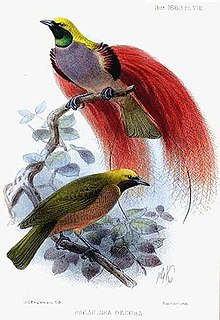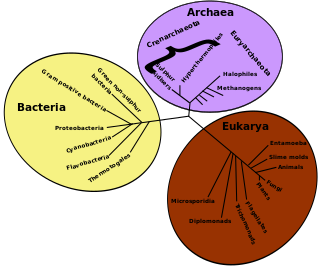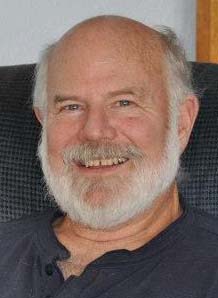Related Research Articles

Natural selection is the differential survival and reproduction of individuals due to differences in phenotype. It is a key mechanism of evolution, the change in the heritable traits characteristic of a population over generations. Charles Darwin popularised the term "natural selection", contrasting it with artificial selection, which in his view is intentional, whereas natural selection is not.

Sexual selection is a mode of natural selection in which members of one biological sex choose mates of the other sex to mate with, and compete with members of the same sex for access to members of the opposite sex. These two forms of selection mean that some individuals have greater reproductive success than others within a population, for example because they are more attractive or prefer more attractive partners to produce offspring. In general, males benefit from frequent mating and monopolizing access to a group of fertile females. Females can have a limited number of offspring and maximize the return on the energy they invest in reproduction.

The modern synthesis was the early 20th-century synthesis reconciling Charles Darwin's theory of evolution and Gregor Mendel's ideas on heredity in a joint mathematical framework. Julian Huxley coined the term in his 1942 book, Evolution: The Modern Synthesis.

Fitness is the quantitative representation of natural and sexual selection within evolutionary biology. It can be defined either with respect to a genotype or to a phenotype in a given environment. In either case, it describes individual reproductive success and is equal to the average contribution to the gene pool of the next generation that is made by individuals of the specified genotype or phenotype. The fitness of a genotype is manifested through its phenotype, which is also affected by the developmental environment. The fitness of a given phenotype can also be different in different selective environments.

In evolutionary biology, fitness landscapes or adaptive landscapes are used to visualize the relationship between genotypes and reproductive success. It is assumed that every genotype has a well-defined replication rate. This fitness is the "height" of the landscape. Genotypes which are similar are said to be "close" to each other, while those that are very different are "far" from each other. The set of all possible genotypes, their degree of similarity, and their related fitness values is then called a fitness landscape. The idea of a fitness landscape is a metaphor to help explain flawed forms in evolution by natural selection, including exploits and glitches in animals like their reactions to supernormal stimuli.

Jack J. Dongarra ForMemRS; is an American University Distinguished Professor of Computer Science in the Electrical Engineering and Computer Science Department at the University of Tennessee. He holds the position of a Distinguished Research Staff member in the Computer Science and Mathematics Division at Oak Ridge National Laboratory, Turing Fellowship in the School of Mathematics at the University of Manchester, and is an adjunct professor in the Computer Science Department at Rice University. He served as a faculty fellow at Texas A&M University's institute for advanced study (2014–2018). Dongarra is the founding director of Innovative Computing Laboratory.

Evolutionary ecology lies at the intersection of ecology and evolutionary biology. It approaches the study of ecology in a way that explicitly considers the evolutionary histories of species and the interactions between them. Conversely, it can be seen as an approach to the study of evolution that incorporates an understanding of the interactions between the species under consideration. The main subfields of evolutionary ecology are life history evolution, sociobiology, the evolution of interspecific interactions and the evolution of biodiversity and of ecological communities.
Gregory M. Cochran is an American anthropologist and author who argues that cultural innovation resulted in new and constantly shifting selection pressures for genetic change, thereby accelerating human evolution and divergence between human races. From 2004 to 2015, he was a research associate at the anthropology department at the University of Utah. He is co-author of the book The 10,000 Year Explosion.

In parapatric speciation, two subpopulations of a species evolve reproductive isolation from one another while continuing to exchange genes. This mode of speciation has three distinguishing characteristics: 1) mating occurs non-randomly, 2) gene flow occurs unequally, and 3) populations exist in either continuous or discontinuous geographic ranges. This distribution pattern may be the result of unequal dispersal, incomplete geographical barriers, or divergent expressions of behavior, among other things. Parapatric speciation predicts that hybrid zones will often exist at the junction between the two populations.
Joan Roughgarden is an American ecologist and evolutionary biologist. She is best known for her rejection of sexual selection and her theistic evolutionism.
ASU's College of Liberal Arts and Sciences is the largest of the 17 independent school units at Arizona State University. Students majoring in The College make up 32 percent of all Tempe campus students and the college fills over 40 percent of all ASU course seats.
Louis J. Gross is distinguished professor of ecology and evolutionary biology and mathematics at the University of Tennessee. He is the founding director of the National Institute for Mathematical and Biological Synthesis and the Institute for Environmental Modeling. His research focuses on computational and mathematical ecology, with applications to plant physiological ecology, conservation biology, natural resource management, and landscape ecology.

Marlene Zuk is an American evolutionary biologist and behavioral ecologist. She worked as professor of biology at the University of California, Riverside (UCR) until she transferred to the University of Minnesota in 2012. Her studies involve sexual selection and parasites.

The extended evolutionary synthesis consists of a set of theoretical concepts argued to be more comprehensive than the earlier modern synthesis of evolutionary biology that took place between 1918 and 1942. The extended evolutionary synthesis was called for in the 1950s by C. H. Waddington, argued for on the basis of punctuated equilibrium by Stephen Jay Gould and Niles Eldredge in the 1980s, and was reconceptualized in 2007 by Massimo Pigliucci and Gerd B. Müller.
Paul A. Wender is an American chemist, focusing in organic chemistry, organometallic chemistry, synthesis, catalysis, chemical biology, imaging, drug delivery, and molecular therapeutics. He is currently the Francis W. Bergstrom Professor of Chemistry at Stanford University and is an Elected Fellow at the American Association for the Advancement of Science and American Academy of Arts and Sciences.

The scientific study of speciation — how species evolve to become new species — began around the time of Charles Darwin in the middle of the 19th century. Many naturalists at the time recognized the relationship between biogeography and the evolution of species. The 20th century saw the growth of the field of speciation, with major contributors such as Ernst Mayr researching and documenting species' geographic patterns and relationships. The field grew in prominence with the modern evolutionary synthesis in the early part of that century. Since then, research on speciation has expanded immensely.
This glossary of evolutionary biology is a list of definitions of terms and concepts used in the study of evolutionary biology, population biology, speciation, and phylogenetics, as well as sub-disciplines and related fields. For additional terms from related glossaries, see Glossary of genetics, Glossary of ecology, and Glossary of biology.
Lee Altenberg is a theoretical biologist. He is a Professor in the Department of Information and Computer Sciences at the University of Hawaii at Mānoa. He is best known for his work that helped establish the evolution of evolvability and modularity in the genotype-phenotype map as areas of investigation in evolutionary biology, for moving theoretical concepts between the fields of evolutionary biology and evolutionary computation, and for his mathematical unification and generalization of modifier gene models for the evolution of biological information transmission, putting under a single mathematical framework the evolution of mutation rates, recombination rates, sexual reproduction rates, and dispersal rates.

Stevan James Arnold is an American evolutionary biologist. He is Professor Emeritus of Integrative Biology and Curator of Amphibians and Reptiles at Oregon State University, Corvallis. He has served as president of the Society for the Study of Evolution and the American Society of Naturalists.
Daniel S. Fisher is an American theoretical physicist working in statistical physics.
References
- ↑ https://www.theaga.org/toronto-key-lecture.htm
- ↑ "Sergey Gavrilets". utk.edu. Retrieved January 22, 2016.
- ↑ "Gavrilets, Sergey". utk.edu. Retrieved January 22, 2016.
- ↑ "Sergey Gavrilets" . Retrieved January 22, 2016.
- ↑ "American Academy Arts and Sciences 2017 Fellows List" . Retrieved April 24, 2017.
- ↑ "Evolution, the Extended Synthesis". Retrieved July 1, 2018.